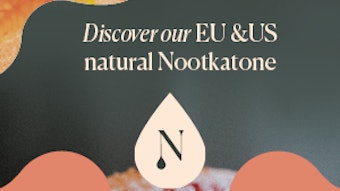
Hexane, a petroleum-derived solvent, has been a cornerstone for extracting plant-based raw materials across the food, cosmetics and fragrance industries for decades. Valued for its strong solvating power, low cost and ease of recovery, hexane has enabled the creation of many high-quality natural extracts used worldwide. It was long assumed hexane was fully recycled or evaporated during processing, leaving no trace in finished products. However, evolving science and societal concerns about health, safety and sustainability invite a careful re-evaluation of its use. This article explores the reasons driving the industry’s gradual transition away from hexane and the opportunities it offers.
Log in to view the full article
Hexane, a petroleum-derived solvent, has been a cornerstone for extracting plant-based raw materials across the food, cosmetics and fragrance industries for decades. Valued for its strong solvating power, low cost and ease of recovery, hexane has enabled the creation of many high-quality natural extracts used worldwide. It was long assumed hexane was fully recycled or evaporated during processing, leaving no trace in finished products. However, evolving science and societal concerns about health, safety and sustainability invite a careful re-evaluation of its use. This article explores the reasons driving the industry’s gradual transition away from hexane and the opportunities it offers.
What is Hexane?
Hexane is not a single molecule, but a mixture of hydrocarbon isomers, with its composition depending on the crude oil source and refining process. Its main component is n-hexane, though it may contain other substances such as benzene or toluene.
Hexane is a non-polar solvent with strong solvating power, and it has long been the standard for industrial-scale extraction thanks to its effectiveness, global availability and low cost. In the flavor and fragrance industries, it has traditionally been used to extract aromatic compounds and natural concretes from botanical raw materials. These techniques have enabled the creation of high-quality extracts used in fine perfumery and food applications. Over time, the sectors have adapted and continue exploring alternative extraction methods to maintain product quality and technical performance while addressing growing concerns about safety and sustainability.
Safety Concerns and Public Health Risks
n-Hexane is a well-documented neurotoxicant. In Europe, it is classified as STOT RE 1 (H372) by the EU’s classification, labelling and packaging regulation (CLP), indicating it can cause damage to the nervous system through repeated exposure. Cases of peripheral neuropathy have been reported among workers exposed via inhalation. It is also classified as a suspected reproductive toxicant (Category 2, H361f) by the CLP. These classifications are supported by robust toxicological data, particularly on its metabolite 2,5-hexanedione, which causes axonal damage.
Hexane’s flammability is a well-known industrial hazard. Historical incidents, including explosions in Copenhagen (1980), Bordeaux (2018) and Dieppe (2018), underline the importance of strict safety measures. Industrial safety standards and handling procedures have significantly evolved since then, greatly reducing such risks.
Moreover, hexane is classified as hazardous to the aquatic environment (H411). Its volatility contributes to the emission of volatile organic compounds (VOCs), which affect atmospheric pollution and ozone formation. Hexane’s fossil-based origin also exposes supply chains to price volatility and geopolitical tensions, impacting industry resilience.
Regulatory Momentum in Europe
Although residual solvent levels are regulated in food, consumers remain unaware of hexane’s use in production, as regulations do not require disclosure of solvents used during extraction. Yet the process leaves measurable residues in finished products, contributing to population-wide exposure.
Two regulatory pathways are currently underway under the European Food Safety Authority (EFSA) and the European Chemicals Agency (ECHA).
 Alternatives to hexane exist, and several companies within fragrance, flavor and related sectors have successfully begun adopting safer extraction methods.hkjdesign at Adobe Stock
Alternatives to hexane exist, and several companies within fragrance, flavor and related sectors have successfully begun adopting safer extraction methods.hkjdesign at Adobe Stock
EFSA has taken up the issue due to the variable composition of hexane and the fact that existing residue limit (1 mg/kg in oils, set in 1996) is not based on a safe dose and is now deemed insufficient. In a technical report published in September 2024, EFSA’s technical report highlights concerns about potential exposure levels to hexane residues, especially in vulnerable groups such as young children, and calls for a reassessment of safety thresholds. EFSA is currently reassessing the safety of hexane as a food extraction solvent, based on toxicological data, composition analyses and exposure information submitted during calls for data. EFSA’s final scientific opinion is expected by November 22, 2027.
In parallel, under ECHA’s jurisdiction, n-hexane has been classified as STOT RE 1 (H372) for its effects on the nervous system. This classification becomes mandatory by May 2026. Furthermore, in February 2025, n-hexane entered the Registry of Intention for Substances of Very High Concern (SVHC). Once a substance is identified as an SVHC, it is added to the Candidate List, triggering enhanced transparency obligations throughout the supply chain, including the communication of safety information to downstream users.
The most significant regulatory consequences result from the inclusion on the Authorization List (Annex XIV) under the REACH regulation, or Registration, Evaluation, Authorization and Restriction of Chemicals. Once listed, companies wishing to continue using the substance must submit a comprehensive authorization dossier demonstrating that risks are adequately controlled or that the socio-economic benefits outweigh those risks. If granted, this authorization is time-limited and must be periodically renewed. This process strongly encourages industry to shift toward sustainable and safe solutions, ultimately aiming to phase out the use of the most hazardous substances.
National Action in France
In March 2025, Bill No. 1078 was introduced in France with the aim of banning the use of hexane and requiring mandatory health warnings on certain finished products. The key measures include:
- Transparency: Hexane residues, currently classified as “processing aids” and thus exempt from labelling, would require a mandatory “may contain hexane” statement.
- Phasing-out: The bill proposes to initially restrict use for vulnerable populations, starting with baby food, medicines, cosmetics, and nutraceuticals, followed by a gradual nationwide ban under the precautionary principle.
- Support: Farmers and SMEs willing to transition would receive financial aid, funded by a tax collected on producers and importers of hexane-extracted goods or animal products from hexane-treated feed.
Benefits and Challenges of Transitioning
Alternatives to hexane exist, and several companies within fragrance, flavor and related sectors have successfully begun adopting safer extraction methods. The use of hexane is explicitly banned in EU organic food production and under the COSMOS Organic standard for cosmetics. Transitioning away from hexane presents multiple benefits:
- Improved safety: Alternatives present significantly lower risks than hexane, particularly in terms of neurotoxicity and long-term exposure. This enhances worker safety and reduces occupational health concerns.
- Lower environmental impact: Alternatives avoid the use of fossil resources and help reduce the carbon footprint of extraction processes.
- Brand and reputational protection: Transitioning to safer alternatives reinforces a brand’s commitment to health, transparency, and sustainability.
- Stronger alignment with corporate sustainability goals: Transitioning away from hexane supports green innovation, Environmental, Social and Governance commitments, and evolving regulatory expectations.
- Access to premium positioning: Alternatives support “hexane-free” claims and enable the development of organic, clean-label, or higher value-added products, offering differentiation in a competitive market.
However, the transition is complex, requiring collaboration across the supply chain, significant R&D investment and process adaptation. Maintaining product quality and technical performance while implementing new solvents or methods is critical to success.
To conclude, while hexane continues to be widely used due to its technical performance and economic viability, growing concerns about its potential impact on human health and the environment have prompted some companies to transition toward alternative extraction methods. These early movers demonstrate that it is possible to maintain high product standards while adopting safer and more sustainable technologies.
At the same time, others are now initiating or accelerating their own shift, encouraged by innovation, changing consumer expectations and the emergence of new regulatory frameworks.
This ongoing industry-wide transformation reflects a shared interest in responsible innovation and long-term sustainability. Its success will depend on close collaboration with suppliers, investment in R&D and forward-looking strategic planning. By proactively engaging with these changes, companies can ensure continuity, strengthen trust with stakeholders and contribute to more sustainable value chains.










